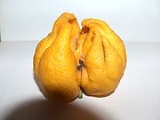
Aceria sheldoni
Encyclopedia
Aceria sheldoni, commonly called the citrus bud mite, is a species of mite
belonging to the family Eriophyidae. It feeds in leaf
- and flower
-bud
s of Citrus
spp, causing deformation to leaves, flowers and fruit
, and is a worldwide pest of citrus fruit production.
This minute yellowish or pinkish mite (reaching only 0.16 mm in length) is active throughout the year with a full generation lasting just 10 days in the summer, maybe twice that in the winter. Each female lays up to 50 eggs which hatch after 2–5 days. The animal goes through 4 pre-imaginal
instar
s before reaching maturity.
As well as the direct damage caused by this species, the hollows caused in affected fruit encourage infestation by other pests including the citrus mealybug, Planococcus citri and the two-spotted spider mite, Tetranychus urticae
.
Mite
Mites, along with ticks, are small arthropods belonging to the subclass Acari and the class Arachnida. The scientific discipline devoted to the study of ticks and mites is called acarology.-Diversity and systematics:...
belonging to the family Eriophyidae. It feeds in leaf
Leaf
A leaf is an organ of a vascular plant, as defined in botanical terms, and in particular in plant morphology. Foliage is a mass noun that refers to leaves as a feature of plants....
- and flower
Flower
A flower, sometimes known as a bloom or blossom, is the reproductive structure found in flowering plants . The biological function of a flower is to effect reproduction, usually by providing a mechanism for the union of sperm with eggs...
-bud
Bud
In botany, a bud is an undeveloped or embryonic shoot and normally occurs in the axil of a leaf or at the tip of the stem. Once formed, a bud may remain for some time in a dormant condition, or it may form a shoot immediately. Buds may be specialized to develop flowers or short shoots, or may have...
s of Citrus
Citrus
Citrus is a common term and genus of flowering plants in the rue family, Rutaceae. Citrus is believed to have originated in the part of Southeast Asia bordered by Northeastern India, Myanmar and the Yunnan province of China...
spp, causing deformation to leaves, flowers and fruit
Fruit
In broad terms, a fruit is a structure of a plant that contains its seeds.The term has different meanings dependent on context. In non-technical usage, such as food preparation, fruit normally means the fleshy seed-associated structures of certain plants that are sweet and edible in the raw state,...
, and is a worldwide pest of citrus fruit production.
This minute yellowish or pinkish mite (reaching only 0.16 mm in length) is active throughout the year with a full generation lasting just 10 days in the summer, maybe twice that in the winter. Each female lays up to 50 eggs which hatch after 2–5 days. The animal goes through 4 pre-imaginal
Imago
In biology, the imago is the last stage of development of an insect, after the last ecdysis of an incomplete metamorphosis, or after emergence from the pupa where the metamorphosis is complete...
instar
Instar
An instar is a developmental stage of arthropods, such as insects, between each molt , until sexual maturity is reached. Arthropods must shed the exoskeleton in order to grow or assume a new form. Differences between instars can often be seen in altered body proportions, colors, patterns, or...
s before reaching maturity.
As well as the direct damage caused by this species, the hollows caused in affected fruit encourage infestation by other pests including the citrus mealybug, Planococcus citri and the two-spotted spider mite, Tetranychus urticae
Tetranychus urticae
Tetranychus urticae is one of many species of plant-feeding mites found in dry environments across the world, and generally considered a pest. It is the most widely known member of the family Tetranychidae or spider mites...
.

